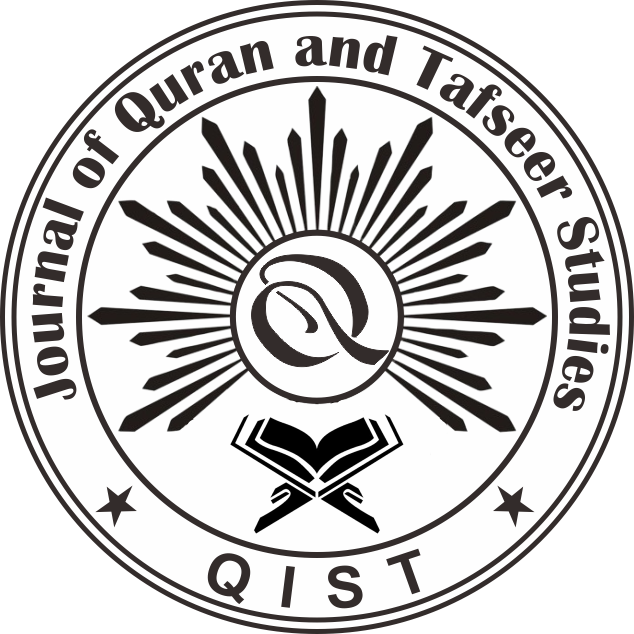No Meaning in the Quran: Sukidi's Thought
DOI:
https://doi.org/10.23917/qist.v4i3.13444Keywords:
Sukidi, Locus of Meaning, Qur'an, ExegesisAbstract
Where do the meanings lie? This is one of the most intriguing questions in Qur'anic studies both in the West and the East. Some scholars say that the meaning of the Qur'an is inherently located in the scripture. Then, Indonesian Salafism came up with the slogan "Back to the Qur'an". However, some scholars challenged that notion and said that no meaning in the scripture, because meanings are located in the tradition, mufassir. Sukidi Mulyadi proposed the notion of "Back to the tradition", instead of to the Qur'an, because no meaning in the Qur'an. This article will elaborate the Sukidi's notion, elucidate his arguments, examine the context and implications of his claims, and then compare with the views of some related scholars, such as Mun'im Sirry and Sahiron Syamsuddin. This work will use the application of qualitative content analysis. With this approach, this article will provide valuable insights into the complexities of Qur'anic exegesis. By doing so, the study not only clarifies Sukidi's contribution but also highlights the broader intellectual dynamics of meaning-making in Qur'anic exegesis. This article demonstrates the novelty of revisiting Sukidi's thesis in dialogue with contemporary Indonesian scholarship, thereby offering significant insights into the evolving contestations of authority and interpretation in Qur'anic studies.
References
[1] N. Hamid A. Zayd, Reformation of Islamic thought: A critical historical analysis, vol. 10. Amsterdam University Press, 2006.
[2] N. Hosen, 'When 'Back to the Qur'an and Hadith'Is No Longer Enough: Radicalisation of Islamic Teaching in Indonesia', in Islam, Education and Radicalism in Indonesia, Routledge, 2023, pp. 321-341.
[3] A. Saeed, 'Some Reflections on the Contextualist Approach to Ethico-Legal Texts of the Quran', Bull. Sch. Orient. Afr. Stud. Univ. Lond., vol. 71, no. 2, pp. 221-237, 2008.
[4] S. R. Burge, 'The Search for Meaning: "Tafsir", Hermeneutics, and Theories of Reading', Arabica, vol. 62, no. 1, pp. 53-73, 2015.
[5] N. H. A. Zayd, Rethinking the Qur'an: Towards a humanistic hermeneutics. Humanistics University Press Utrecht, The Netherlands, 2004.
[6] Kamil Alfi Arifin, Sukidi, inspirasi dan api pembaruan Islam dari Harvard. Jakarta: PT Gramedia Pustaka Utama, 2022.
[7] Nirwansyah, 'Sukidi, Pendekar dari Harvard'. Accessed: Jan. 06, 2024. [Online]. Available: https://mediaindonesia.com/weekend/552367/sukidi-pendekar-dari-harvard
[8] B. Stowasser, 'The Qur'an and Its Meaning', Arab Stud. J., vol. 3, no. 1, pp. 4-8, 1995.
[9] R. Simon, Histoire critique du vieux testament. Chez Reinier Leers, 1967.
[10] A. Bevilacqua, 'The republic of Arabic letters: Islam and the European enlightenment', in The Republic of Arabic Letters, Harvard University Press, 2018.
[11] A. Jeffery, 'The Qur'an as Scripture Iv', Muslim World, vol. 40, no. 4, pp. 257-274, 1950, doi: https://doi.org/10.1111/j.1478-1913.1950.tb01053.x.
[12] W. A. Graham, 'The Earliest Meaning of "Qur'an"', Welt Islams, vol. 23/24, pp. 361-377, 1984, doi: https://doi.org/10.2307/1570680.
[13] Sukidi Mulyadi, 'Tuhan Bersumpah Demi Al-Qur'an', Suara Muhammadiyah, Yogyakarta, pp. 44-45, 2023.
[14] A. bin I. Qummi, 'Tafsir al-Qummi', Qom Dar Al-Kitab, 1984.
[15] A. al-Qasim Al-Zamakhshari, Tafsir al-Kasysyaf. Dar al-Kutub al-Ilmiyyah.
[16] Sukidi Mulyadi, ''Abd Allah b. 'Abbas: Nabi Muhammad Melihat Tuhan', Suara Muhammadiyah, Yogyakarta, pp. 44-45, 2023.
[17] Sukidi Mulyadi, 'Muhammad Melihat Tuhan: Dengan Mata atau Hati?', Suara Muhammadiyah, Yogyakarta, pp. 44-45, 2023.
[18] Sukidi Mulyadi, 'The Gradual Qur'an: Views of Early Muslim Commentators'. Accessed: Jan. 19, 2024. [Online]. Available: https://dash.harvard.edu/handle/1/42029833
[19] A. Fadilah, 'Ma'na-Cum-Maghza Sebagai Pendekatan Kontekstual dalam Perkembangan Wacana Hermeneutika Alquran di Indonesia', J. QURAN HADITH Stud., vol. 8, no. 1, Art. no. 1, June 2019, doi: https://doi.org/10.15408/quhas.v8i1.13383.
[20] M. A. Sirry, Controversies over Islamic origins: a introduction to traditionalism and revisionism. Newcastle: Cambridge Scholars Publisching, 2021.
[21] A. Saeed, Interpreting the Qurʼan: towards a contemporary approach. Abingdon [England]; New York: Routledge, 2006.
[22] A. Saeed, 'Reading the Qur'an in the twenty-first century: A contextualist approach', Read. Quran Twenty-First Century Context. Approach, pp. 1-200, Dec. 2013, doi: https://doi.org/10.4324/9781315870922.
[23] S. Syamsuddin, 'MA'NA-CUM- MAGHZA APROACH TO THE QUR'AN: INTERPRETATION OF Q. 5:51', presented at the International Conference on Qur'an and Hadith Studies (ICQHS 2017), Atlantis Press, Nov. 2017, pp. 131-136. doi: https://doi.org/10.2991/icqhs-17.2018.21.
[24] Sukidi Mulyadi, 'Penafsiran Qur'an di Islam Perdana', Suara Muhammadiyah, Yogyakarta, pp. 46-47, 2024.
[25] P. Crone, Meccan Trade and the Rise of Islam. Gorgias Press, 2004.
[26] M. İ. Yüksek, "The Context and Conceptual Framework of the Discussions on 'Can there be Verses in the Qur'an whose Meaning is Unknown?,'" Mutefekkir, vol. 11, no. 21, pp. 29-53, 2024, doi: https://doi.org/10.30523/mutefekkir.1501576.
[27] B. Demircigil, "Disputes on the Meanings of the 'al-Jin' in the Qur'an," Cumhur. Ilah. Derg., vol. 26, no. 1, pp. 433-449, 2022, doi: https://doi.org/10.18505/cuid.1076156.
[28] A. S. Sıcak, "Tafannun (stylistic variation) in similar meanings and utterances in the Quran," Cumhur. Dent. J., vol. 23, no. 2, pp. 739-763, 2019, doi: https://doi.org/10.18505/cuid.598291.
[29] M. Ayyıldız, "According to Elmalılı, The Possibility of Translation of the Quran in Terms of the Unity of Order and Meaning," Islam Tetkikleri Derg., vol. 13, no. 2, pp. 541-563, 2023, doi: https://doi.org/10.26650/iuitd.2023.1295512.
[30] M. Jarrah, M. J. Zuraikat, and E. Al-Shawashreh, "Prophecy and illiteracy: The meaning of ʔummij in the holy qur'an," Jordan J. Mod. Lang. Lit., vol. 12, no. 2, pp. 151-165, 2020, [Online]. Available: https://www.scopus.com/inward/record.uri?eid=2-s2.0-85087424816&partnerID=40&md5=0d93a99425cd88e25e93416f34b72815
[31] M. Z. Zakaria, M. N. Khairuddin, A. A. M. Isa, M. A. A. Majid, F. A. A. Suparia, and M. S. M. Raffi, "Implicit Meanings in the Quran: A Pragmatic Perspective," Theory Pract. Lang. Stud., vol. 14, no. 11, pp. 3546-3556, 2024, doi: https://doi.org/10.17507/tpls.1411.23.
[32] K. Haggag and A. Abduallah, "Briefing of the deletion in the Holy Qur'an, its meaning and effect on the context," Quranica, vol. 16, no. 2 Special Issue 12, pp. 411-445, 2024, [Online]. Available: https://www.scopus.com/inward/record.uri?eid=2-s2.0-85217030069&partnerID=40&md5=6fe0d9c806a4faf2e7eef4bab761d45f
[33] M. I. A. Al-Suwaigh, "THE ORDER OF MEANINGS IN THE HOLY QURAN FROM THE PERSPECTIVE OF DR. ABDULLAH DRAZ," Eur. J. Philos. Relig., vol. 16, no. 3, pp. 113-133, 2024, doi: https://doi.org/10.24204/ejpr.2024.4530.
[34] D. J. Stewart, "The Meaning and Usage of laʿalla in the Qur'an," J. Qur'anic Stud., vol. 25, no. 3, pp. 89-138, 2023, doi: https://doi.org/10.3366/jqs.2023.0557.
[35] H. Hassanein, "Less Form, More Meaning: A Case Study of al-Iẖtibak in the Qur'an Through the Prism of Dependency Grammar," SAGE Open, vol. 13, no. 4, 2023, doi: https://doi.org/10.1177/21582440231199921.
[36] I. M. A. Rujaibi, "Aesthetic Terms in the Qur'an: An Analysis of their Meaning and Usage," Islam. Q., vol. 67, no. 2, pp. 169-210, 2023, [Online]. Available: https://www.scopus.com/inward/record.uri?eid=2-s2.0-85182413332&partnerID=40&md5=9830a42a88bcf39fd01d6e946dca5ee4
[37] M. D. Ababneh, B. H. Al-Azzam, and A. M. Al-Amar, "The Reflection of Connotative Meanings of Insan in the Qur'an: A Translational and Semantic Perspective," Theory Pract. Lang. Stud., vol. 13, no. 2, pp. 525-534, 2023, doi: https://doi.org/10.17507/tpls.1302.30.
[38] C. A. Aydın, "The Meanings of the Word 'Aziz' in the Quran," Darulf. Ilah., vol. 34, no. 2, pp. 451-491, 2023, doi: https://doi.org/10.26650/di.2023.34.2.1341913.
[39] J. Al-Saudi, "Translation of Polysemous Meanings of the Word 'Qadha' (قض ى) in the Holy Qur'an: An Analytical Semantic Study," Dirasat Hum. Soc. Sci., vol. 50, no. 2, pp. 265-274, 2023, doi: https://doi.org/10.35516/hum.v50i2.4936.
[40] T. J. Gunn and O. Sabil, "Shari'a in the Qur'an: A Word Meaning 'Law' or a Metaphor Evoking 'Path'?," in Boundaries of Religious Freedom: Regulating Religion in Diverse Societies, International University of Rabat, Sale, Morocco: Springer Science and Business Media B.V., 2023, pp. 23-54. doi: https://doi.org/10.1007/978-3-031-27188-5_2.
[41] A. Ismail and A. Solahuddin, "Psychology of patience and semantic approach to the Qur'an: Meaning of Qala on Istirja' Verse," Cogent Arts Humanit., vol. 10, no. 1, 2023, doi: https://doi.org/10.1080/23311983.2023.2168342.
[42] I. Albayrak, "Revisiting the Meaning of the Divine Preservation of the Qur'an: With Special References to Verse 15:9," Religions, vol. 13, no. 11, 2022, doi: https://doi.org/10.3390/rel13111064.
[43] A. Galadari, "Re-Visiting the Meaning of 'ẓann' in the Qur'an," Muslim World, vol. 112, no. 4, pp. 436-456, 2022, doi: https://doi.org/10.1111/muwo.12450.
[44] I. B. M. Qubaisi, "The Meaning of and Wisdom Behind the Seven Letters (Dialects) And the Difference Between them and the Seven Recitations (of the Quran)," Quranica, vol. 14, no. 1 Special Issue 8, pp. 319-341, 2022, [Online]. Available: https://www.scopus.com/inward/record.uri?eid=2-s2.0-85218780431&partnerID=40&md5=45714baf4fd0baa36ab47898d87e829c
Downloads
Submitted
Accepted
Published
How to Cite
Issue
Section
License
Copyright (c) 2025 Yusuf Rohmat Yanuri, Ahmad Bayu Setiawan

This work is licensed under a Creative Commons Attribution 4.0 International License.
















